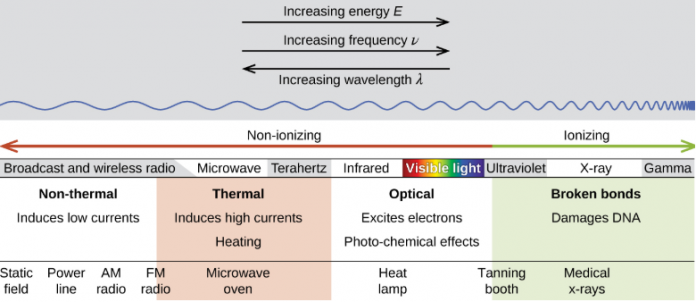Radiation
The energy or particles that travel from the source through space or other mediums are called radiations. These radiations can cause harmful effects on an individual if they are exposed to the radiation for a very long time. Light, heat, wireless communication, and microwaves are all forms of radiation.
Types of Radiation
We know that radiation is an energy that travels in space. Based on the energy of the radiated particles there are two types of radiation. The radiations are classified as ionizing radiation and Non-ionising radiation.
Lonising Radiation
This radiation has enough energy to produce ions in the matter at the molecular level TDNA and cause denaturation of proteins. Ionizing radiation is emitted by radioactive atomic structures as very high energy (Gamma rays and X rays) or as actual particles like (alpha, beta, neutrons). They differ in energy, mass, and penetration power.
Penetration of Lonizing Radiation
The radiations like gamma rays, X-rays, and Neutrons penetrate through the body easily. Lead is used as a shield to these rays. Alpha and beta particles can be blocked by the skin with beta particles penetrating more into the skin and can cause burns.
Non-ionising Radiation
This radiation injury is limited to burns. The non-ionizing comes in the form of Microwaves, lasers, Infrared, Visible spectrum, and ultraviolet rays.
Let us discuss few radiations in detail.
Alpha Particles
These are the heaviest particles with two neutrons and two protons. The naturally occurring radioactive materials in the earth consist of uranium and thorium which emit alpha particles. Alpha particle is very heavy and has a very large charge, therefore, it does not penetrate much into the material. However, if one were to ingest or inhale materials that emit alpha particles then tissues of the lungs can be exposed. An application of alpha particles is seen in smoke detectors when the alpha particles are stopped by smoke, thereby triggering the alarm.
Beta Particles
Beta particles are electrons that do not get attracted to an atom. They have a small mass and has a negative charge. Cosmic radiation in the atmosphere produces Tritium which emits beta radiation. Carbon-14 commonly used in carbon-dating of fossils emits beta particles. By measuring the beta particles given out by the carbon-14 we can determine the amount of carbon-14 left in the fossil, which helps in finding out how long ago the organism was alive. Beta particles are also useful in cancer therapy if radioactive material is put in a tumor.
Neutron
Neutrons do not have any charge and it is present in the nucleus of the atom. Neutrons are seen during fission reactions and splitting of uranium atoms. Nuclear reactors used to generate power uses neutrons to sustain the reaction. Since neutrons do not have any charge they do not interact with the particles and can penetrate through them. Using large quantities of water can stop the neutrons.
Electromagnetic Radiation
X-rays and gamma rays are examples of electromagnetic radiation. These rays are widely used in medical treatments. They do not have a charge or mass. The amount of energy of these radiations can range from a very low level to very high levels.
Effects of Radiation
Some sources of radiation give off larger amounts of radiation than others. Let’s take the example of an airport scanner, we are exposed to very less radiation from the scanner, this does not affect the health of a person. But if a person is living near the site of a nuclear accident he is exposed to more radiation and there are more effects of radiation on the person. It can cause some serious damage to a person’s health.
Effects of Radiation on Human Body
(i) Hair: Hair loss is a side effect of exposure to radiation of more than 200 rems.
(ii) Brain and heart: Brain cells are damaged only if the radiation is more than 5,000 rem. Since the brain cells do not reproduce. High radiation kills nerve cells and small blood cells in the heart and can cause seizures and sudden death.
(iii)Thyroid: Thyroid gland is damaged by radioactive iodine. The effects of exposure can be reduced by potassium iodide.
( iv) Blood system: Exposure to radiation more than 100 rems can reduce lymphocyte cell count. This is also called mild radiation sickness.
(v) Gastrointestinal tract: When a person is exposed to radiation of 200 rems or more it can cause damage to the intestinal tract lining which causes symptoms like nausea, bloody vomiting, and diarrhea.
(vi) Reproductive tract: Long-term exposure to radiation can cause damage to the reproductive tract cells.
Protective Measures
Exposure to natural radiation cannot be avoided completely. But certain measures can be taken to reduce the exposure to man-made sources.
- Avoiding going out in the sun during midday. Using sunscreen and clothes that cover the skin if we have to go out in the afternoon.
- Take a CT scan and X-ray only if necessary, especially for children.

